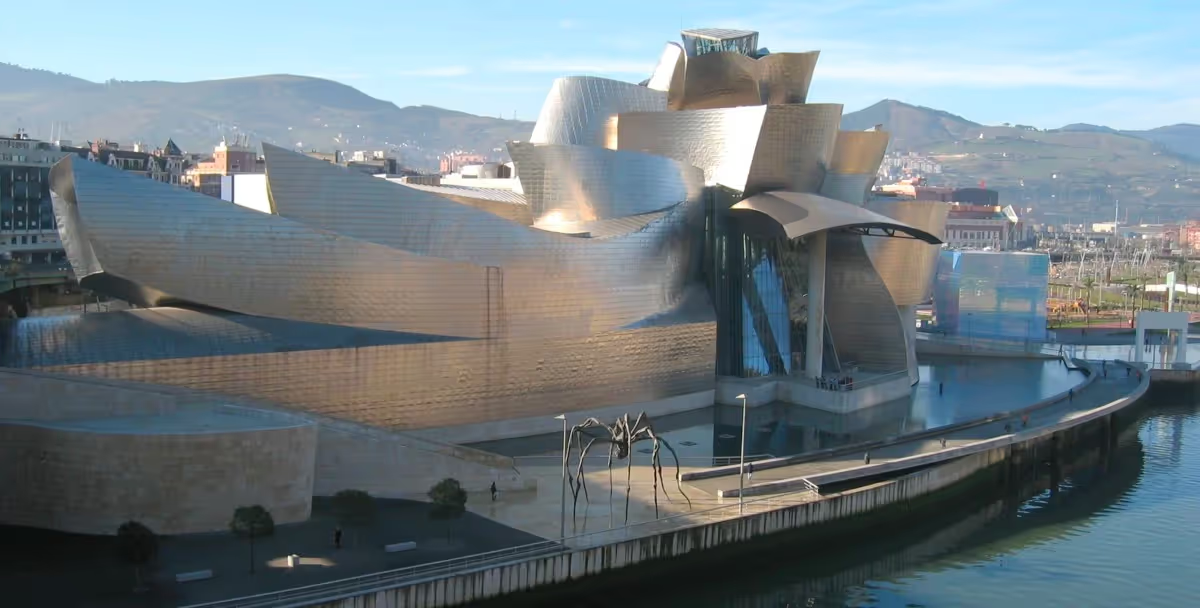The Bilbao Effect : How the Design of a Museum Transformed The Economy of The City

What’s In This Blog?
- Introduction
- Why The Design of The Museum Is Unique & Iconic
- How a City Transformed From Dying to Famous
- What the Travel Data Says
- Other Cities Inspired by The Bilbao Effect
- Conclusion
Introduction

The Bilbao Effect is a term used by economists to describe the economic and social impact of the Guggenheim Museum. The museum was built in 1997 and is one of the world's most visited museums.
Before its completion, Bilbao was a city with high levels of unemployment and poverty.
But after building the $100 Million Guggenheim Museum, things changed drastically for this Spanish town.
Why The Design of the Museum Is Unique & Iconic.

The Guggenheim Bilbao is a masterpiece of architecture. It was designed by Frank Gehry, who has been hailed as one of the greatest architects of our time. The building is a work of art and stands out from any other building in the city.
The structure has become a symbol for Bilbao and attracts thousands of tourists yearly who marvel at its beauty and design. This beautiful structure has become an icon for Bilbao, attracting visitors worldwide with its unique architecture.

Frank Gehry was particularly fascinated with the movement of fish. In an interview with journalist Charlie Rose in 1997, Gehry mentions, "I was interested in movement, and when a fish moves, it's so beautiful; I started to make forms like that and was able to achieve that sense of movement, and I developed an architectural vocabulary."
The museum's design consists of a series of interconnected volumes. The volumes are covered with orthogonal coated stone and some with organic skin with a titanium skeleton. A glass skin creates the intersection of these volumes.
The museum does not try to overshadow the city's other buildings in terms of materials and height. Limestone and sandstone, in particular, are used for this reason.
How a City Transformed From Dying to Famous.

Gehry claims he was nervous when he won the competition to build the museum. In an interview with The Guardian, he says the following on his first meeting with the city officials "They said: 'Mr. Gehry, we need the Sydney Opera House. Our town is dying.' I looked at them and said: 'Where's the nearest exit? I'll do my best, but I can't guarantee anything."
As we now know, the result is a majestic, beautiful structure of titanium and stone that sits on the river Nervión. A piece of art that resembles a ship but also looks like it flips its tail like a jumping fish.
The "Bilbao Effect," however, is not the first of its kind. Sydney's Opera House, Paris' Pompidou center, and many other cities such as Frankfurt, Glasgow, and Pittsburgh all used iconic architecture to improve their cities' economy and status.
But it's called the "Bilbao Effect" and not the "Sydney Effect" because of the stark contrast of the ambition to transform Bilbao. Bilbao was a post-industrial wasteland. The city was built on dying shipbuilding and steel industries, which were impossible to revitalize for the 21st Century. Cities like Sydney, Paris, and Frankfurt were already modern metropolitan cities with a flourishing artistic and architectural culture.
The museum has completely changed the landscape of Bilbao by bringing millions of tourists from all over the world. Bilbao has now become Spain's most captivating destination for tourists and investors.
The Guggenheim Museum's socio-economic impact more than met its objective of transforming the city's image, with calculations in 2017 suggesting that the museum generates around €400 million per year for the local economy.
What the Travel Data Says.

In its first three years, nearly 4 million tourists visited the Guggenheim museum, generating about €500 million in economic activity. International visitors exceeded local ones for the first time in 2003, with 43% of visitors coming from abroad. The regional council estimated that the money visitors spent on hotels, restaurants, shops, and transport allowed it to collect €100 million in taxes, which more than paid for the building cost.
The building has been featured in various movies and videos, such as the 1999 James Bond film starring Pierce Brosnan, Mariah Carey's music video for the song "Sweetheart," and even in a South Indian film called "Sivaji."
But the museum is more than just a tourist attraction. It's why Bilbao's economy has recovered from its darkest days.
Other Cities Inspired by The Bilbao Effect.

Centre Pompidou-Metz, France, designed by Shigeru Ban, 2010
The Architects themselves claim that the Bilbao Effect was a huge inspiration in their attempt to create a sculpture in a relatively unknown city to bring in international tourism.

The Public, West Bromwich, designed by Will Alsop, 2008
A £72m Public arts center in West Bromwich brought in 1 million visitors within the first four years of its opening. It was described as a "Playground for Adults" that would host art, comedy, and even cinemas. It brought tourists from all over the country but shut down in 2013 before seeing it grow to its real potential.

Centre Niemeyer, Avilés, Spain, designed by Oscar Niemeyer, 2011
A cultural center that put the city of Avilés on the map after the famous Woody Allen visited it at its opening. Popular artists and stars such as Brad Pitt and Kevin Spacey saw the works and further increased publicity of the cultural complex.

Ordos Museum, China, by MAD Architects, 2011
Located in the city of Ordos, in the Gobi Desert, the museum was built to bring in more visitors to the newly built city that could cater to the needs of 1 million citizens.

Louvre Museum, Abu Dhabi designed by Jean Nouvel, 2017
Built with an agreement between the governments of UAE & France, the Louvre brought in 2 million visitors in the first two years of its opening. Leveraging the existing tourists from the ever-growing Dubai, located only 2 hours away by road.
Conclusion

The Bilbao Effect is an excellent example of how architecture and design can positively affect the economy and culture of a city.
The Guggenheim Museum has brought pride, tourism, and economic growth to Bilbao since opening its doors in 1997. And while not every project will have such an impact as this one, it's clear that good design can make all the difference in revitalizing urban areas with both functional and beautiful buildings.
But perhaps, our favorite part of this entire process is a quote by Frank Gehry that more architects should learn from, "People are always telling me how I changed the city; I didn't mean to change the city; I just meant to be part of the city."



